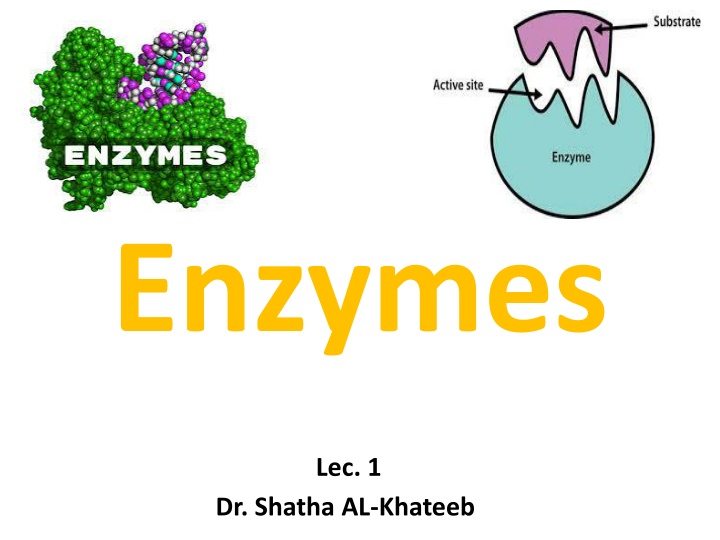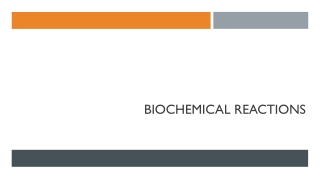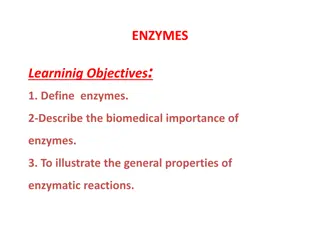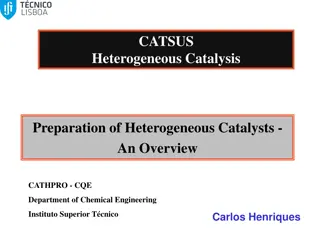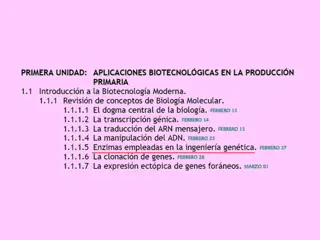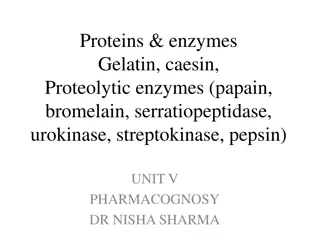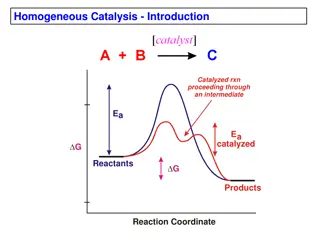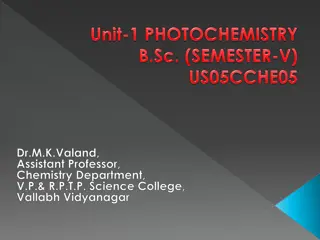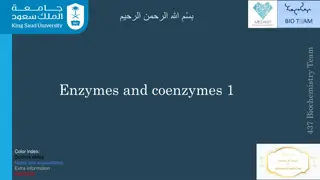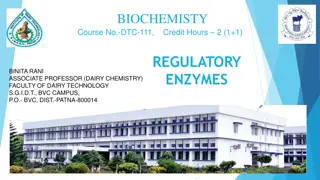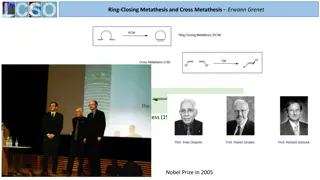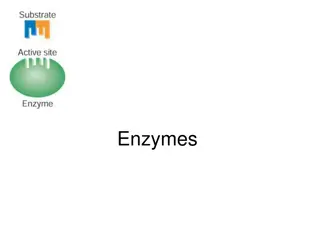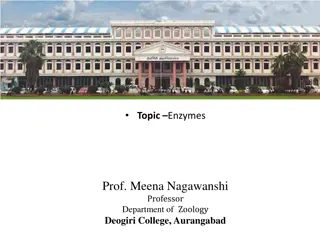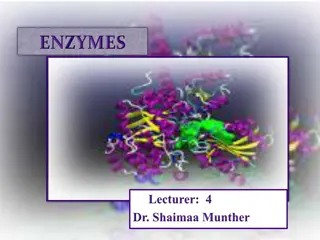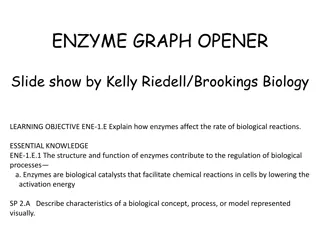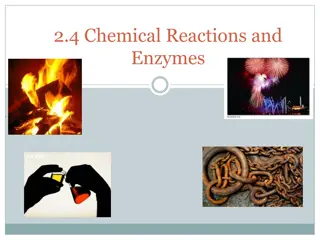Enzymes: The Key Catalysts in Biochemical Reactions
Enzymes are biological catalysts that play a crucial role in various life processes by speeding up chemical reactions. They are specific, protein-based molecules that lower the activation energy required for reactions, ensuring proper metabolism and efficiency in living organisms. Factors like pH, temperature, and enzyme concentration affect their activity, highlighting their essential role as regulators in biochemical pathways.
Download Presentation

Please find below an Image/Link to download the presentation.
The content on the website is provided AS IS for your information and personal use only. It may not be sold, licensed, or shared on other websites without obtaining consent from the author.If you encounter any issues during the download, it is possible that the publisher has removed the file from their server.
You are allowed to download the files provided on this website for personal or commercial use, subject to the condition that they are used lawfully. All files are the property of their respective owners.
The content on the website is provided AS IS for your information and personal use only. It may not be sold, licensed, or shared on other websites without obtaining consent from the author.
E N D
Presentation Transcript
Enzymes Lec. 1 Dr. Shatha AL-Khateeb
There are multiple reactions that take place inside our body (such as digestion of food, secretion of hormones, production of energy, etc. require enzymes.) These bio-reactions that occur in our body during various life processes also require catalysts; the substances that act as biocatalysts for the reactions inside our body are called enzymes. Catalysts are those substances that enhance the rate of a chemical reaction without themselves getting chemically modified. They increase the rate of reaction by lowering the activation energy of the reaction. Enzymes are often referred to as the biological catalysts.
The catalysts of biochemical reactions are enzymes and are responsible for bringing about almost all of the chemical reactions in living organisms. Without enzymes, these reactions take place at a rate far too slow for the pace of metabolism. All known enzymes are proteins. They are high molecular weight compounds made up principally of chains of amino acids linked together by peptide bonds.
Enzymes are bio-active organic molecules found in the cells of both prokaryotes and eukaryotes, they are biomolecules that are highly specific, itis a macromolecule that catalyses a biochemical reaction, interacts with a substrate, converting it into a new product. All metabolic processes in the body need enzymes to catalyse reaction at a faster rate. The majority of enzymes are globular proteins
Enzymes are catalysts. They act as a catalyst to a chemical or biochemical reaction, with a defined mechanism. They increase the speed of that reaction, typically by 106-1014times faster than the rate of the un-catalysed reaction. They are selective for a single substrate. They speed up rate of reaction by lowering the activation energy They are stereospecific, meaning the reaction produces a single product.
All the reactions require the biomolecule as definite controlling system. The control should be for the direction, speed and specificity of the undergoing reaction. The enzymes are always produced in the proper amounts, at the proper time and the proper place where they are needed and they are different factors that affect enzyme activity i.e., pH, Temperature, Enzyme and Substrate Concentration.
General Properties Of Enzymes *The activity of enzymes depends upon the acidity of medium (pH specific),most active at a specific pH. * Enzymes can accelerate the reaction in either direction. * All enzymes possess active sites which participate in the biochemical reactions. * Enzymes are very unstable compounds mostly soluble in water, dilute glycerol, NaCl and dilute alcohol. * Enzymes act actively at optimum temperature. * All enzymes are protein in nature .
The Most Important Properties Of An Enzyme Are: 1.Catalytic Property 2.Specificity 3.Reversibility 4.Sensitiveness to heat and temperature and pH
Colloidal Nature Enzymes behave as colloids due to their large size or high molecular weight. Enzyme Precipitation Acidic and alkaline solution can cause enzyme precipitation, as the enzymes are amphoteric (possess amino and carboxylic acid group towards the end of the chain). Molecular Weight Enzymes are large protein biomolecules possessing a polypeptide chain of various amino acid sequence. Nearly 200 to 300 peptide bonds hold the amino acids together. Therefore, enzymes have a high molecular weight. Enzyme Solubility Enzymes are soluble in water, NaCl, diluted glycerol and alcohol. Enzyme Denaturation High heat (above 40 degrees Celsius) and alternations in the pH (too low and too high), heavy metals, and high salt concentration etc., denatures the enzyme by breaking the intra and inter-molecular noncovalent bonds. It distorts the enzyme s shape and active site and finally results in the loss of enzyme activity.
Specific shape: Enzymes have a specific shape which they maintain even after a reaction. Reuse: Enzymes can be reused again and again because no reaction can mortalize them. The specificity of reaction: Every enzyme is specific for a specific reaction. For Example, A. Maltase enzyme is used to break down Maltose into Glucose+Glucose. While Lactase enzyme is used to break down Lactose into Glucose+Galactose.
Sensitivity: Enzymes are much more sensitive to the change of temperature and PH because they work better at a moderate temp and PH, lower and higher values of both may cause disturbance or can stop enzyme activity. Used in small amounts: Enzymes are used in a small amount because they are powerful and can easily provide basic necessities for a reaction Active Site/Centre: Enzymes have a specific active site where the entire reaction takes place. Active sites need a substrate to attach itself with it. The substrate can be protein or lipid etc.
Enzyme specificity Enzymes show different levels of specificity which are: 1- Absolute specificity: In this condition, the enzyme reacts only on a specific substrate e.g. Lactase acts on lactose. 2- Group specificity (Structural specificity): In this condition, the enzyme acts on a special type of bond at a specific site and attached to specific groups e.g.: Pepsin: acts on peptide bond between the amino group of aromatic amino acid and the carboxylic group of another amino acid . Trypsin: acts on peptide bonds between the carboxylic group of basic amino acid and the amino group of another amino acid.
3- Relative specificity: In this condition, the enzyme acts at different rates on one type of bond in compounds chemically related e.g. pancreatic lipase hydrolyses the alpha ester bonds at positions 1 & 3 in Triglycerides. 4- Stereochemical specificity: enzymes act on D or L isomers e.g. D-Amino acid oxidase acts only on D-amino acids L- Amino acid oxidase acts only on L- amino acid Enzymes act on a specific type of linkages according to the type of linkage { or ) of the compounds attached to it e.g. Amylase hydrolyses -1.4 glycosidic linkage of starch. .
Terminology of enzymes Enzymes that were discovered early were given general names which they are still used as ptyalin, pepsin, trypsin,, etc Now a suffix (ase) is added to indicate enzyme. The prefix may be: 1-Name indicating general nature of substrate e.g.: protease, lipase etc 2-The real name of the substrate: urease, lactase, sucrase. 3-Type of reaction catalysed e.g.: Aldolase, mutase, 4-Combination of the above e.g.: Name of substrate + type of reactions.g.: lactic acid Dehydrogenase ,Glycogen Synthetase
Distribution of Enzymes Cytoplasmic Enzymes: Those enzymes which are found dissolved in the fluid part of the cell. Mitochondrial Enzymes: These enzymes are found mainly in Mitochondria the powerhouse of the cell where major process respiration takes place. Plastid Enzyme: Enzymes which are found in the process of Photosynthesis ,plastid is a part of Chloroplast. Ribosomal Enzymes: Enzymes which are found in the process of Protein Synthesis Holo Enzymes: Enzymes which are composed of Protein part and non-Protein Apo Enzymes: The function is to remove the non-Protein part from an enzyme or just the Protein part is called Apo Enzymes.
NOMENCLATURE Each enzyme is a s signed two names . The first is its short, recommended name , convenient for every day use . The second is the more complete systematic name , which is used when an enzyme must be identified without ambiguity.
Recommended name Most commonly used enzyme names have the suffix ase attached to the substrate of the reaction (for example, glycosidase and urease) . Or to a description of the action performed (for example , lactate dehydrogenase and adenylyl cyclase). Some enzymes retain their original trivial name s , which give no hint of the associated enzymic reaction, for example, trypsin and pepsin
Systematic name In the systematic naming system, enzymes are divided into six major classes , each with numerous subgroups . For a given enzyme, the suffix (ase) is attached to a fairly complete description of the chemical reaction catalyzed, including the name s of all the substrates. Each enzyme is also assigned a classification number.
Classes of Enzymes 1. Oxidoreductases Catalyze oxidation-reduction reactions - oxidases - peroxidases - dehydrogenases 2. Transferases Catalyze group transfer reactions 3. Hydrolases Catalyze hydrolysis reactions where water is the acceptor of the transferred group - esterases - peptidases - glycosidases 4. Lyases Catalyze lysis of a substrate, generating a double bond in a nonhydrolytic, nonoxidative elimination 5. Isomerases Catalyze isomerization reactions 6. Ligases (synthetases) Catalyze ligation, or joining of two substrates Require chemical energy (e.g. ATP)
Oxido-reductases are further classified into five subgroups: A- Oxidases These are enzymes that catalyse direct transfer of hydrogen to oxygen and form water e.g. cytochrome B- Aerobic Dehydrogenases These are enzymes that catalyse direct transfer of hydrogen to oxygen and form hydrogen peroxide (H 2O 2) e.g. L-amino and D-amino acid oxidase. C- Anaerobic dehydrogenases These are enzymes cannot transfer hydrogen directly to oxygen but hydrogen is indirectly transferred to oxygen through many hydrogen carriers e.g. glucose- 6-phosphate dehydrogenase .phenylalanine
D- Hydroperoxidase These enzymes use hydrogen peroxide (H 2O 2) as substrate changing it into water (H 2O) e.g. peroxidases and catalases E- Oxygenases These enzymes catalyze direct incorporation of oxygen into substrate. e.g. i- Dioxygenases (True oxygenases): These enzymes catalyze incorporation of two oxygenatoms into substrate e.g. tryptophan pyrrolase enzyme. ii- Monooxygenases (pseudo-oxygenases or hydroxylases): These enzymes incorporate one oxygen atom into substrate e.g.
Transferases These are enzymes that catalyze transfer of a chemical group from one compound to another. Theyinclude: A- Transaminases These are enzymes that catalyze transfer of amino group (-NH 2) from amino acid to ?-keto acid producing new amino acid and new keto acid e.g. i- Alanine transaminase (ALT): It is also called serum glutamic pyruvic transaminase (SGPT). ii- Aspartate transaminase (AST): It is also called serum glutamic oxalacetic transaminase (SGOT).
B- Acyl transferases These enzymes catalyze the transfer of acyl (fatty acid) group to compounds. They need Coenzyme-A that acts as a carrier for acyl group e.g. choline acetylase. C- Methyl transferases These enzymes transfer methyl group (-CH 3) from methyl donor usually active methionine (S-adenosyl methionine) to the substrate e.g. formation of epinephrine (adrenaline) from norepinephrine (noradrenaline). D- Phosphotransferases These enzymes catalyze transfer of phosphate group e.g. hexokinase and glucokinase both catalyze transfer of phosphate group from ATP to glucose.
Hydrolases These enzymes catalyze cleavage of their substrates by addition of water.All the digestive enzymes are hydrolases. Hydrolases include: A- Enzymes hydrolyzing glycosidic link in carbohydrates These enzymes catalyze hydrolysis of carbohydrates e.g. maltase, lactase, sucrase and amylase. B- Lipase: Enzyme that hydrolyzes triglyceride into glycerol and three fatty acids.
C- Proteases: Enzymes that catalyze hydrolysis of proteins (proteolytic enzymes). e.g. pepsin and Trypsin D- Phosphatases: These enzymes catalyze hydrolysis of phosphoric acid esters e.g.. i-Phosphomonoesterases that catalyze hydrolysis of phosphoric acid monoesters as glucose-6-phosphatase ii- Phosphodiesterases that catalyze hydrolysis of phosphoric acid diesters e.g. the enzyme that catalyzes the hydrolysis of cAMP (cyclic adenosine monophosphate) to AMP.
Lyases (desmolases) These enzymes catalyze cleavage of substrates or removal of chemical groups by mechanisms other than addition of water i.e. by mechanisms other than hydrolysis. They include: A. Aldolase: It is an enzyme that splits aldehyde from alcohol e.g. fructose-1-6- diphosphate aldolase. B. Dehydratases: These enzymes catalyze removal of water from their substrates e.g. fumarase and carbonic anhydrase. C. Decarboxylases: These enzymes catalyze the removal of CO2 from their substrates. They need pyridoxal phosphate (PLP) as coenzyme e.g. amino acids decarboxylases as histidine decarboxylase, which removes CO2 from histidine changing it to histamine. D. Phosphorylases: These enzymes catalyze cleavage of their substrates by addition of phosphoric acid e.g. glycogen phosphorylase.
Isomerases: These enzymes catalyze intramolecular rearrangement, so they catalyze conversions between optical, positional and geometric isomers They include: A. Aldose-ketose isomerases: These enzymes catalyze interconversion between aldoses and ketoses e.g. B. Epimerases: These enzymes catalyze interconversion between epimers e.g. C. Mutases: These enzymes catalyze transfer of chemical group from one position to another in the same compound e.g. D. Racemases: These enzymes catalyze interconversion between D & L enantiomers e.g. E. Cis-Trans isomerases: These enzymes catalyze interconversion between cis and trans geometric isomers. Cis-trans isomerase Trans retinol Cis retinol
Lyases which involve elimination reactions in which a group of atoms is removed from the substrate. This includes the aldolases, decarboxylases, dehydratases and some pectinases but does not include hydrolases. Lyases normally cleave C-C, C-N and C-O bonds between molecules. Often this leads to the formation of double bonds between molecules. It also leads to the formation of ring structures. Lyases differ from hydrolases due to not adding water into the products.
What are the Similarities Between Lyases and Transferases? Lyases and transferases are two of the six major groups of enzymes. They catalyze biochemical reactions and increase the rate of reaction by lowering the activation energy. They are made from amino acid sequences. Hence, they are proteins and have an active site to bind with their specific substrates. They are involved with many important biochemical pathways in living organisms. In fact, they are integral parts of important processes in life.
Ligases also known as synthetases, form a relatively small group of enzymes which involve the formation of a covalent bond joining two molecules together, coupled with the hydrolysis of a nucleoside triphosphate. For example: glutathione synthase (EC 6.3.2.3, systematic name, g-L-glutamyl-L- cysteine:glycine ligase (ADP-forming); also called glutathione synthetase).
